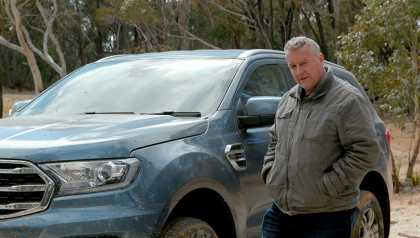The Mitsubishi Pajero Sport has been updated for 2020: it has Mitsubishi's ‘Dynamic Shield' front grill, it's had a slap and tickle on its rear end – with shorter tail-light sections the most noteworthy tweak – and it also has a revised media unit inside.
It's been nice to drive in the past – on and off the road – and it has a fair bit of driver-assist technology and other features as standard, but what makes this seven-seat ute-based 4WD wagon possibly stand out in a market that already has quite a few them, including the likes of the standard-setting Ford Everest as well as Isuzu MU-X, Toyota Fortuner and Holden Trailblazer?
Read on.
Mitsubishi Pajero Sport 2020: GLS (4x4) 7 Seat
| Engine Type | Diesel Turbo 4, 2.4L |
|---|---|
| Fuel Type | Diesel |
| Fuel Efficiency | 8.0L/100km (combined) |
| Seating | 7 |
| Price From | $45,210 - $52,580 |
| Safety Rating |
|
Does it represent good value for the price? What features does it come with?
The GLS is the mid-spec Pajero sport in a three-variant range.
It has a 2.4 litre, four-cylinder turbo-diesel engine and an eight-speed automatic transmission (for more details, read "What are the key stats for the engine and transmission?", below).
Of particular note, it is equipped with AEB, as well as Apple CarPlay and Android Auto. Other standard features include active cruise control, dusk-sensing headlights, rain-sensing wipers, six-speaker sound system, power tailgate, privacy glass, and leather-appointed, power-adjustable seats. It has twin-spoke 18-inch alloy wheels.
.jpg)
It misses out on blind-spot monitoring and rear cross traffic alert and the like though, which top-spec Exceed has.
This seven-seater GLS, as tested, costs $53,230; $52,490 (MRLP) plus Terra Rossa paint ($740).
Is there anything interesting about its design?
The look of Pajero Sport's back-end, with its long tail-lights, has been a bit polarising – a fair few people did not like it – but Mitsubishi has addressed those perceived design issues by tweaking the tail-lights so they are now abbreviated, stopping short of the rear bumper.
Elsewhere, the Sport's exterior is sleek looking and easy on the eye.
Inside, it is very nice as well. This is not the top-spec Exceed, but it certainly feels like a premium-level offering with snug supportive seats, a plethora of soft-touch surfaces and supreme ease of operation.
What are the key stats for the engine and transmission?
Its 2.4 litre, four-cylinder turbo-diesel engine produces 133kW at 3500rpm and 430Nm at 2500rpm and it has an eight-speed auto, a four-wheel-drive system with high- and low-range, selectable off-road modes, including gravel, sand, snow/mud (when in high-range 4WD) and rock (when in low-range 4WD), as well as a centre diff-lock (which is activated when 4HLc (4WD high-range, locked centre diff) or 4LLc (4WD low-range, locked centre differential) is selected, and a rear diff lock (which is engaged/disengaged via a button in front of the shifter). It also has 2H (two-wheel drive high-range), which drives off the rear wheels.
.jpg)
How practical is the space inside?
The Pajero Sport is 4825 millimetres long with a 2800mm wheelbase. It is 1915mm wide, 1835mm high and it has a listed kerb weight of 2105kg.
Boot space is claimed to be 131 litres with the third row seats in use. In the boot are power sockets and tie-down points. Fold the third row out of the way and cargo space increases to 502 litres and the seats fold down almost entirely out of the way.
With the second and third rows folded down and out of the way, you have access to a claimed combined 1400 litres of cargo space.
.jpg)
Passengers in the third-row seat have access to cup-holders and air vents.
Second-row passengers have access to three top tether points, two ISOFIX points and a fold-down arm-rest with cup holders. There are USB charge points and a power socket in the back of the centre-console bin.
The second row is rather comfortable; I sat behind my driving position and there was plenty of head and leg room.
Up front, the seats (power-adjustable driver and front passenger) are very supportive, with a nice wrap-around snug feel to them.
The steering wheel has paddle shifters for sporty shifting and it is reach- and height-adjustable.
The dash and 8.0-inch touchscreen media unit is slick-looking and integrated. All buttons and dials are easy to locate and easy to operate, even when you're bouncing around off-road.
What's it like as a daily driver?
On road, it's a rather smooth-driving wagon.
Steering is light and precise and that fits nicely with the Pajero Sport because it's a light and nimble 4WD wagon. It really is quite manoeuvrable and it feels it, as well.
The engine and eight-speed auto are a punchy combination – rarely stressed – and throttle response is nice and sharp.
Another good aspect of the Pajero Sport is the fact it is equipped with Super Select II, which we've praised in the past and which is in the Pajero and Triton. It really is an effective system, adding an extra element of safety and sure-footedness to your driving experience.
.jpg)
It's also a substantial point of difference with a lot of other 4WDs because Super Select II gives you the freedom to drive the Pajero Sport in 4H (four-wheel drive high-range), which acts as an all-wheel-drive system would, and is safe to use in high-traction situations, such as dry bitumen roads, and helps to produce optimal traction in low-traction situations, such as wet roads and loosely gravelled tracks. There's no risk of transmission wind-up because the centre diff is open when 4H is engaged in the Pajero Sport.
Suspension, however, is a bit firm. The ride can be a little bit jarring at times through harsher sections of rough back-country bitumen and even more so through deeper potholes, ruts and corrugations on dirt tracks. It's noticeable, but never terrible.
Inside the Pajero Sport is something to write home about: it has a well-appointed interior, fit and finish is great, build quality feels really solid. It's never quite as refined as something like the Ford Everest, but it's pretty damn close.
What's it like for touring?
Off-road, it is very capable, largely because you're able to tap into a few different ways designed to help you to tackle the rough stuff.
Firstly, it has selectable off-road modes, including gravel, sand, mud/snow (when in high-range 4WD) and rock (when in low-range 4WD). All of those adjust engine output, transmission settings and braking, with the aim being to produce superior traction to suit those specific conditions and terrains.
Secondly, it has decent high- and low-range gearing and a very effective Super Select II 4WD system. Via a dial near the shifter, you can switch from 2H into 4H (four-wheel drive high-range), if you're not already driving with 4H engaged, and that gives you the best traction possible in low-traction conditions, which you may face on back-country roads and dirt tracks.
.jpg)
Then turn the dial to 4HLc (four-wheel drive high-range locked centre diff) and you're set to take on more difficult terrain but at lower speeds, because the centre diff is no longer open.
If you're keen to tackle even harder stuff that high-range territory, turn the dial to 4LLc (four-wheel drive low-range locked centre diff) and the Pajero Sport has a real opportunity to excel in low-speed low-range four-wheel driving.
Thirdly, as well as its centre diff-lock – which is activated when 4HLc (4WD high-range, locked centre diff) or 4LLc (4WD low-range, locked centre diff) is selected – the Pajero Sport has a rear diff lock, which is engaged/disengaged via a button in front of the shifter.
We took on several short steep hills, up and down, and this Mitsubishi conquered them, no problem. Except for one – but more about that later.
.jpg)
When you're in low range, the Pajero Sport's centre diff is locked and it gives you plenty of terrain-grabbing torque, that traction, to get you up and over. Safe progress is easily achievable with the Mitsu's sustained, controlled momentum.
Hill descent control works well, sustaining controlled low speed all the way down every hill.
Its riding on Toyo Open Country A32 all-terrain tyres (265/60R18 110H), supposedly designed for the Pajero Sport, but it could really do with more aggressive rubber, for even more grip, in order to be even more effective off-road.
Wheel travel is good, ground clearance is pretty good, although you still have to mind your driving line through rough terrain and be mindful of approach, departure and ramp-over angles.
.jpg)
One steep and slippery clay rock hill in particular was a decent challenge and proved too much for the Pajero Sport. We trucked most of the way up the hill, but the Mitsu couldn't quite clear a little severe rock shelf near the crest and as such prevented any further safe progress.
All-round, the Pajero Sport is an effective off-road package. It does everything safely; you always feel in control and that's a key to getting up and over things, no matter what the challenge. And also having lots of fun.
This Sport has a maximum listed payload of 670kg. It has a listed maximum towball load of 310kg, and its towing capacity is 750kg (unbraked) and 3100kg (braked). It has a gross vehicle mass of 2775kg, and a gross combined mass of 5400kg.
There are plenty of Pajero Sport accessories available from Mitsubishi, including bulbar and nudge bars, snorkels, tow bar kits, cargo barriers and more.
How much fuel does it consume?
The Sport has a claimed fuel consumption of 8.0L/100km on a combined cycle. It was showing 10.2 on our dash and that was pretty close because our actual fuel consumption figure on test was 10.1L/100km. The Pajero sport has a 68-litre fuel tank.
It has a 68-litre fuel tank.
Warranty & Safety Rating
What safety equipment is fitted? What safety rating?
The Pajero Sport has a five-star ANCAP safety rating based on testing in October, 2015.
Safety gear includes AEB, adaptive cruise control, blind spot warning and rear cross traffic alert.
What does it cost to own? What warranty is offered?
The Pajero Sport has a seven-year/150,000km warranty, but that offer is currently scheduled to end on March 31, 2020.
Mitsubishi's seven-year/150,000km warranty applies to the Pajero Sport range, but the current end date for that offer is March 31 2020. Buyers taking advantage of that offer will also receive two years of free scheduled servicing. That runs until March 31, otherwise the normal warranty of 5yrs/100,000km applies.
Capped price servicing is available and costs $299 each time at 15,000km/12 months, 30,000km/24 months), and 45,000km/36 months.
Verdict
The Mitsubishi Pajero Sport is a well-made, well-priced family friendly wagon. It drives nicely on and off road.
Its interior is nice and comfortable and it's a fully functional 4WD tourer. It's also great value for money, but is it the best thing in the realm of seven-seater ute-based 4WD wagons?
Well, no, because it just never quite reaches the refinement heights of the Ford Everest but it's certainly one of the best priced and most feature-packed vehicles on offer.
And I reckon the GLS is the pick of the bunch.
Pricing Guides



.jpg)
.jpg)
.jpg)
.jpg)
.jpg)
.jpg)
.jpg)
.jpg)
.jpg)
.jpg)
.jpg)
.jpg)
.jpg)
.jpg)
.jpg)
.jpg)







































.png)








.png)




.jpg)
.jpg)

.jpg)

